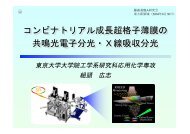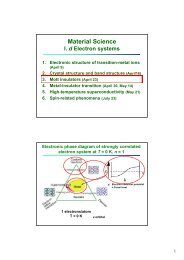Thesis High-Resolution Photoemission Study of Kondo Insulators ...
Thesis High-Resolution Photoemission Study of Kondo Insulators ...
Thesis High-Resolution Photoemission Study of Kondo Insulators ...
Create successful ePaper yourself
Turn your PDF publications into a flip-book with our unique Google optimized e-Paper software.
8.2. Experimental 113<br />
and Fisk [8.2] for the first time, we stress another similarity between FeSi and YbB12<br />
that almost non-dispersing bands exist just below EF [8.4]. In the band structure <strong>of</strong><br />
FeSi calculated by Mattheiss and Hamann [8.3], a band located just below the gap<br />
has a very small dispersion <strong>of</strong> a few tens meV along the ΓX, ΓM, and ΓR directions.<br />
This is in contrast with the conduction bands just above EF , which are moderately<br />
dispersing. The narrow band on the occupied side in FeSi has been observed in recent<br />
angle-resolved PES studies [8.5, 6].<br />
Angle-integrated PES studies <strong>of</strong> FeSi have revealed an opening <strong>of</strong> the pseudogap<br />
<strong>of</strong> 40-50 meV [8.7, 9] with a finite spectral weight at the bottom <strong>of</strong> the pseudogap.<br />
The depression <strong>of</strong> the spectral DOS in FeSi is not so sharply dipped as that in YbB12<br />
and thus the spectral weight at EF would remain finite even if the broadening due to<br />
instrumental resolution has been removed. Breuer et al. [8.7] stated based on their<br />
high-resolution (∆E ∼ 5 meV) photoemission data that a full gap at EF , if opens,<br />
should be less than 1 meV.<br />
In this work, we have made a detailed study <strong>of</strong> substitution effect on the electronic<br />
structure <strong>of</strong> FeSi. Systematic substitution effects have been observed not only in the<br />
pseudogap around EF but also on a higher energy scale, which was not possible to<br />
identify in the spectra <strong>of</strong> Fe1−xCoxSi because <strong>of</strong> the differences between Fe 3d- and Co<br />
3d-related structures.<br />
8.2 Experimental<br />
FeSi1−xAlx (x = 0.00, 0.02, 0.05, 0.10, and 0.30) polycrystals were prepared by arc<br />
melting Fe, Si, and Al in an argon atmosphere [8.8]. An excess Si and Al <strong>of</strong> ∼ 5%<br />
was incorporated in the starting stoichiometry. The samples were checked to be single<br />
phases by powder x-ray diffraction analysis. The electrical resistivity <strong>of</strong> the prepared<br />
samples are shown in Fig. 8.2 [8.8]. The x = 0.02, 0.05, and 0.10 samples exhibit<br />
semiconducting behavior above the resistivity maxima at ∼ 35 K, ∼ 70 K, and ∼ 95 K,<br />
respectively, with almost the same activation energy as that <strong>of</strong> pure FeSi [8.8]. At lower<br />
temperature, the resistivity decreases on cooling down as in a metal. The resistivity <strong>of</strong><br />
the x = 0.30 sample decreases monotonously on cooling below room temperature.<br />
We have performed PES measurements on these samples using a newly developed<br />
PES systems with a VG He lamp and an Omicron EA 125 HR analyzer. The advantage<br />
<strong>of</strong> this system compared with the previous one, which was used for the measurements






